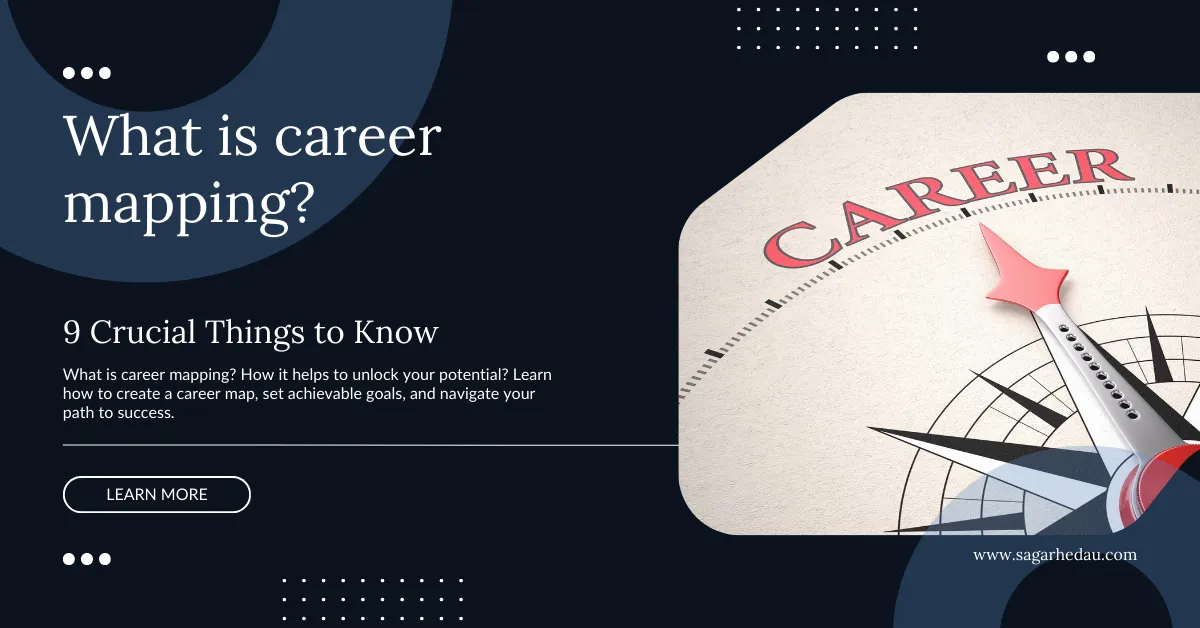Are you feeling stuck in your current job? Dreaming of a more fulfilling career but not sure how to get there? It’s time to discover the power of career mapping. This game-changing strategy can help you take control of your professional life and chart a course to your dream job.
So, what is career mapping and why it matters? How you can use it to skyrocket your success? Get ready to transform your career and unlock your true potential!
What is Career Mapping?
Career mapping is a strategic planning process that helps you visualize and plan your professional journey. It’s like creating a roadmap for your career, outlining where you are now, where you want to go, and the steps you need to take to get there. This powerful tool allows you to:
- Identify your current skills and strengths
- Set clear, achievable career goals
- Pinpoint areas for growth and development
- Create actionable plans to reach your objectives
- Track your progress and adjust your strategy as needed
Think of career mapping as your personal GPS for professional success. It gives you direction, helps you navigate obstacles, and keeps you focused on your ultimate destination.
Career Mapping for Different Stages of Your Career
Career mapping isn’t just for those starting out. At different stages of your career, your focus and goals will naturally evolve.
Early Career: Laying the Foundation
In the early stages of your career, the focus is on gaining experience, building skills with skill development training programs, and exploring different roles to find what you enjoy and where your strengths lie. Your career map at this stage might involve setting goals related to learning and development, such as pursuing certifications or gaining experience in different departments.
Mid-Career: Reassessing and Realigning
Mid-career is often a time for reassessment. You might find yourself questioning whether you’re on the right path or considering a change. This is a great time to revisit your career map, reassess your goals, and make any necessary adjustments. Perhaps it’s time to aim for a leadership role, or maybe you’re considering a shift to a different industry.
Late Career: Preparing for Retirement or a Career Shift
As you approach the later stages of your career, your focus may shift towards preparing for retirement or transitioning to a different kind of work, such as consulting or part-time roles. Your career map at this stage might include goals related to financial planning, knowledge transfer, or even pursuing passions and interests outside of your current field.
What is Career Mapping & Why it Matters?
In today’s fast-paced, ever-changing job market, career mapping is more important than ever. Here’s why:
- Clarity and Direction: Career mapping provides a clear picture of your professional path, helping you make informed decisions about your future.
- Motivation and Focus: By setting concrete goals, you’ll stay motivated and focused on what really matters in your career.
- Adaptability: A well-crafted career map allows you to adapt to industry changes and seize new opportunities as they arise.
- Skill Development: Identifying skill gaps helps you prioritize learning and development opportunities.
- Confidence Boost: Having a solid plan increases your confidence and empowers you to take charge of your career.
- Better Decision-Making: With a career map, you can evaluate job opportunities and make choices that align with your long-term goals.
The Role of Organizations in Career Mapping
Organizations play a crucial role in supporting career mapping. Employers can support career development by offering training and development programs, providing opportunities for career advancement, and encouraging a culture of continuous learning. When organizations invest in their employees’ career growth, they benefit from increased engagement, higher retention rates, and a more skilled workforce.
Integrating career mapping into employee development programs can also be beneficial. This might involve offering career coaching, creating individualized development plans, or providing access to career assessment tools. When employees see a clear path for growth within their organization, they’re more likely to stay and contribute to the company’s success.
How to Create Your Career Map?
Ready to start mapping your career? Follow these steps to create a powerful, personalized career map:
Step 1: Self-Assessment
Begin by taking a deep dive into your current situation. Ask yourself:
- What are my strengths and weaknesses?
- What skills do I possess?
- What are my values and passions?
- What motivates me in my work?
Be honest with yourself during this process. The more accurate your self-assessment, the more effective your career map will be.
Step 2: Define Your Career Goals
Now it’s time to dream big! Consider where you want to be in 5, 10, or even 20 years. Ask yourself:
- What job title do I aspire to have?
- What industry do I want to work in?
- What kind of work environment do I thrive in?
- What salary range am I aiming for?
Remember, your goals should be SMART: Specific, Measurable, Achievable, Relevant, and Time-bound.
Step 3: Research Your Desired Career Path
Once you’ve identified your goals, it’s time to do some homework. Research the career path you’re interested in:
- What qualifications are required?
- What skills are in demand?
- What’s the typical career progression?
- Who are the key players or companies in this field?
This research will help you understand what it takes to succeed in your chosen career.
Step 4: Identify Skill Gaps
Compare your current skills and qualifications with those required for your dream job. Identify any gaps and create a plan to bridge them. This might involve:
- Taking additional courses or certifications
- Gaining relevant work experience
- Developing soft skills like leadership or communication
- Learning new technologies or software
Step 5: Create Action Steps
Break down your long-term goals into smaller, manageable action steps. For each goal, ask yourself:
- What specific actions do I need to take to achieve this?
- What resources do I need?
- What’s my timeline for completing each step?
Be as detailed as possible in your action plan. The more specific you are, the easier it will be to follow through.
Step 6: Visualize Your Career Map
Now it’s time to bring your career map to life! Create a visual representation of your career journey. This could be:
- A flowchart or timeline
- A mind map
- A vision board
- A digital career mapping tool or app
Choose a format that resonates with you and makes your career path easy to understand at a glance.
Step 7: Review and Revise Regularly
Your career map isn’t set in stone. As you grow and change, so will your goals and aspirations. Set aside time every 6-12 months to review and update your career map. Ask yourself:
- Am I on track with my goals?
- Have my interests or priorities changed?
- Are there new opportunities I should consider?
Be flexible and willing to adjust your map as needed.
Key Benefits of Career Mapping
- Increased Job Satisfaction: By aligning your career with your values and passions, you’re more likely to find fulfillment in your work.
- Faster Career Advancement: With a clear plan and focused effort, you can progress more quickly towards your career goals.
- Better Work-Life Balance: Career mapping helps you prioritize what’s truly important, both professionally and personally.
- Enhanced Networking: As you work towards your goals, you’ll naturally expand your professional network and open up new opportunities.
- Greater Resilience: A well-crafted career map helps you bounce back from setbacks and stay focused on your long-term objectives.
- Improved Decision-Making: With a clear view of your career path, you can make more informed choices about job offers, training opportunities, and career moves.
Tools and Resources for Career Mapping
Fortunately, there are plenty of tools and resources available to help with career mapping. Career assessment tools and tests can provide valuable insights into your strengths, weaknesses, and potential career paths. Professional mentorship and networking are also invaluable resources. A mentor can offer guidance, support, and valuable industry insights, while networking can open doors to new opportunities.
Online platforms like LinkedIn Learning, Coursera, and Udemy offer a wealth of courses that can help you develop the skills you need to achieve your career goals. Whether you’re looking to learn new technical skills or develop your leadership abilities, these platforms can provide the resources you need to succeed.
Career Mapping Success Stories
To inspire you on your career mapping journey, let’s look at a couple of success stories:
Sarah’s Tech Triumph: Sarah, a marketing assistant, used career mapping to transition into a tech role. By identifying her passion for data analysis and setting clear goals, she pursued relevant certifications and landed a job as a data analyst within two years. Today, she’s a senior data scientist at a leading tech company, earning twice her previous salary.
Mark’s Entrepreneurial Evolution: Mark, a corporate accountant, always dreamed of running his own business. Through career mapping, he identified the skills and experience he needed to succeed as an entrepreneur. Over five years, he gradually built his side hustle into a thriving small business consultancy, allowing him to leave his corporate job and become his own boss.
These stories demonstrate the power of career mapping to transform professional lives and achieve ambitious goals.
Overcoming Common Career Mapping Challenges
While career mapping is a powerful tool, you may encounter some challenges along the way. Here’s how to overcome them:
- Fear of Commitment: Worried about committing to a specific path? Remember, your career map is flexible. Start with short-term goals and adjust as you go.
- Overwhelm: If the process feels overwhelming, break it down into smaller steps. Focus on one section of your map at a time.
- Lack of clarity: Not sure what you want? Start by exploring your interests and values. Consider working with a career coach for additional guidance.
- Impatience: Remember, career growth takes time. Celebrate small wins along the way to stay motivated.
- External Pressures: Don’t let others’ expectations derail your plans. Stay true to your own goals and values.
Future of Career Mapping
As the world of work continues to evolve, so too will the practice of career mapping. Technology is already playing a significant role, with AI and data analytics providing more personalized and accurate career guidance. The rise of the gig economy and remote work is also changing the way we think about careers, requiring more flexible and adaptable career maps.
In the future, career maps will need to be more dynamic, and capable of adapting to rapid changes in the job market and individual career goals. As lifelong learning becomes increasingly important, career mapping will continue to be an essential tool for navigating a successful and fulfilling career.
Conclusion
Career mapping is a powerful tool that can transform your professional life. By taking the time to assess your skills, define your goals, and create a clear action plan, you’re setting yourself up for long-term success and fulfilment. Remember, your career map is a living document that will evolve with you over time.
Embrace the journey, stay flexible, and keep your eyes on the horizon. With a well-crafted career map in hand, you’re ready to navigate the twists and turns of your professional path with confidence and purpose. So, what are you waiting for? Start mapping your way to career success today!
Frequently Asked Questions About What is Career Mapping?
How is career mapping different from a traditional career plan?
Career mapping is more dynamic and visual than a traditional career plan. It emphasizes the journey and allows for multiple paths to reach your goals, rather than focusing solely on the end destination.
Can career mapping help if I’m not sure what I want to do?
Absolutely! Career mapping can be especially helpful if you’re unsure about your career path. It encourages self-reflection and exploration, helping you discover what truly motivates and excites you professionally.
Is career mapping only for young professionals?
Not at all! Career mapping is valuable at any stage of your professional life. Whether you’re just starting out, looking to make a mid-career change, or planning for retirement, a career map can help guide your decisions.
How often should I update my career map?
It’s a good idea to review your career map at least once a year, or whenever you experience a significant life change or career milestone. Regular reviews ensure your map stays relevant and aligned with your evolving goals.
Can I have multiple career paths on my map?
Yes! In fact, it’s often beneficial to explore multiple potential paths. This allows for flexibility and helps you adapt to changing circumstances or opportunities.


